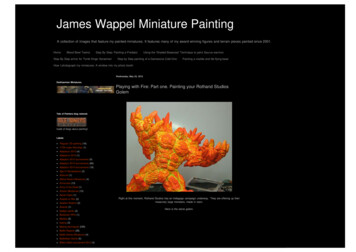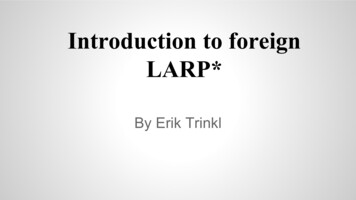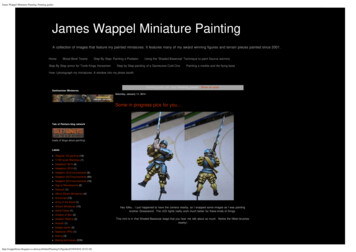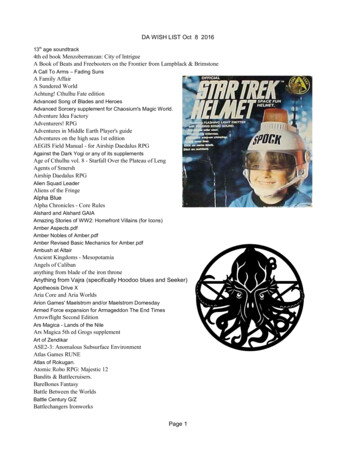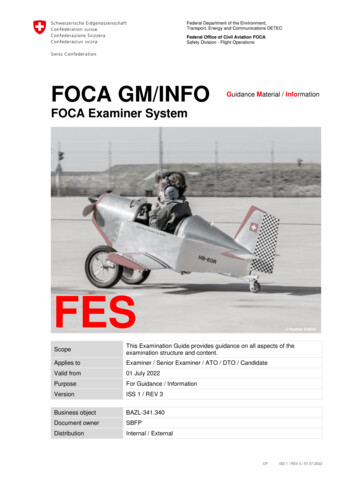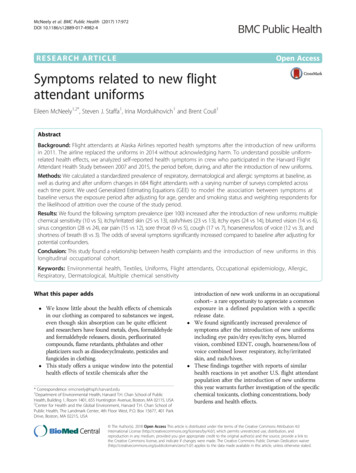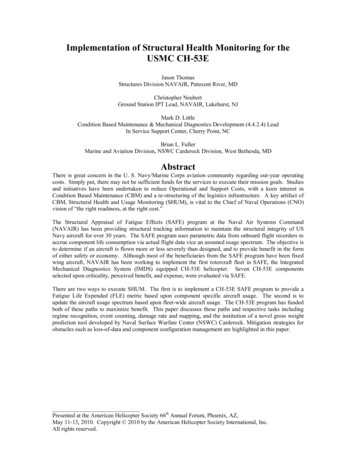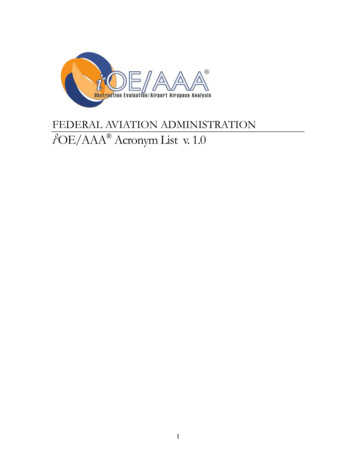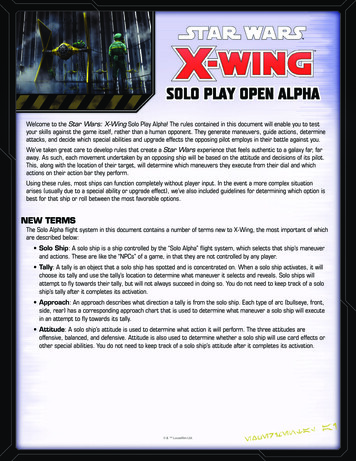
Transcription
Welcome to the Star Wars: X-Wing Solo Play Alpha! The rules contained in this document will enable you to testyour skills against the game itself, rather than a human opponent. They generate maneuvers, guide actions, determineattacks, and decide which special abilities and upgrade effects the opposing pilot employs in their battle against you.We’ve taken great care to develop rules that create a Star Wars experience that feels authentic to a galaxy far, faraway. As such, each movement undertaken by an opposing ship will be based on the attitude and decisions of its pilot.This, along with the location of their target, will determine which maneuvers they execute from their dial and whichactions on their action bar they perform.Using these rules, most ships can function completely without player input. In the event a more complex situationarises (usually due to a special ability or upgrade effect), we’ve also included guidelines for determining which option isbest for that ship or roll between the most favorable options.NEW TERMSThe Solo Alpha flight system in this document contains a number of terms new to X-Wing, the most important of whichare described below: Solo Ship: A solo ship is a ship controlled by the “Solo Alpha” flight system, which selects that ship’s maneuverand actions. These are like the “NPCs” of a game, in that they are not controlled by any player. Tally: A tally is an object that a solo ship has spotted and is concentrated on. When a solo ship activates, it willchoose its tally and use the tally’s location to determine what maneuver it selects and reveals. Solo ships willattempt to fly towards their tally, but will not always succeed in doing so. You do not need to keep track of a soloship’s tally after it completes its activation. Approach: An approach describes what direction a tally is from the solo ship. Each type of arc (bullseye, front,side, rear) has a corresponding approach chart that is used to determine what maneuver a solo ship will executein an attempt to fly towards its tally. Attitude: A solo ship’s attitude is used to determine what action it will perform. The three attitudes areoffensive, balanced, and defensive. Attitude is also used to determine whether a solo ship will use card effects orother special abilities. You do not need to keep track of a solo ship’s attitude after it completes its activation.
SOLO INTRODUCTORY SCENARIOTo familiarize yourself with the Solo Alpha rules for Star Wars: X-Wing, play the following introductory scenario.This scenario is designed to allow you to focus on learning how the Solo Alpha rules generate maneuvers for eachenemy ship. It pits two player-controlled ships (hereafter “player ships”) against several waves of enemies (hereafter“solo ships”).WHAT SHIPS DO I NEED?The Solo Alpha rules are designed to work with any ships in Star Wars: X-Wing, but it will be easiest to learn thebasics while flying a few straightforward and reliable ships against multiple weaker opponents. The following page hasrecommendations for which ships to use for your first few games, but you can replace them with similar ships fromyour collection as you see fit.Even if you only have a single Core Set, an X-wing and two TIE Fighters are perfectly suitable for this scenario!Just place any TIEs you destroy off to the side, to arrive in following rounds as reinforcements.WHAT IF I STILL WANT TO PLAY WITH A FRIEND?The Solo Alpha rules are intended to fly enemy ships for you, but you don’t necessarily have to play alone when usingthem! This scenario can also be played with two or more players, each controlling a single player ship and workingtogether to defeat each successive wave of enemies. This is a good way to teach another player, or to play togetherwithout competition.
REQUIRED COMPONENTS: A 3’x3’ play area. Standard X-Wing rules, templates, tokens, and dice. 2 Hyperspace tokens from the Core Set Escalation game mode. A player squad of 2 ships, controlled by you, consisting of:- 2 Player ships from the following list, one with the highest Initiative non-limited pilot,the other with the lowest Initiative non-limited pilot. An enemy squad of 6 solo ships, controlled by the Solo Alpha rules, consisting of:- 2 Patrol ships from the following list, each with the lowest Initiative non-limited pilot.- 2 Patrol ships from the following list, each with the highest Initiative non-limited pilot.- 2 Reinforcement ships from the following list, each with the highest Initiative non-limited pilot. No ships are equipped with any upgrades except for those listed:2 Player Ships (2 Plastic Ship Miniatures,4 Plastic Pegs, 2 Plastic Bases)1 Rulebook3x3 Play Area2 Reinforcement Ships (2 PlasticShip Miniatures, 4 Plastic Pegs, 2Plastic Bases)2 HyperspaceMarkers12 Templates6 Dice(3 Red, 3 Green)4 Patrol Ships (4 Plastic ShipMiniatures, 8 Plastic Pegs,4 Plastic Bases)Various Tokens
FactionPatrol ShipReinforcement ShipPlayer ShipGalactic RepublicV-19 TorrentBTL-B Y-wing * or Delta-7Aethersprite **ARC-170 or Delta-7Aethersprite**Separatist AllianceVulture DroidNantex Fighter or HyenaDroid *Belbullab-22Rebel AllianceZ-95 HeadhunterRZ-1 A-wing *** orBTL-A4 Y-wing *T-65 X-wing orA/SF-01 B-WingGalactic EmpireTIE/ln Fighter or TIE/agAggressorResistanceFireballRZ-2 A-wing *** orResistance Transport *T-70 X-wingFirst OrderTIE/fo FighterTIE/ba Interceptor or TIE/sf Fighter ***TIE/sf Fighter ****Scum & VillainyZ-95 Headhunter or M3-AInterceptor or MiningGuild TIE/lnFang Fighter or BTL-A4Y-wing *Kihraxz Fighter orG-1A StarfighterTIE/in Interceptor orTIE/sa Bomber *TIE Advanced x1*equipped with Proton Torpedoes***equipped with Concussion Missiles**equipped with Calibrated Laser Targeting****equipped with Special Forces GunnerSQUAD-BUILDINGIf you would like to build your own squads, use the following rules: The player squad consists of 1 or more ships, with a combined total of 35-45 points (or approximately 2 Threatif using Quick Build cards) per ship. The enemy squad should consist of more ships than the player squad, and be divided into three groups:- A first wave of Patrol ships, with a points or Threat total around half of the player squad’s total.- A second wave of Patrol ships similar to the first, with a points or Threat totalalso around half of the player squad’s total.- A third wave of Reinforcement ships, with a points or Threat total slightly less than the player squad’s total.These ships might not all be used in the game.In general, the enemy squad should consist of individually weaker ships, but more of them. Few upgradesshould be included, so as not to distract from learning the Solo Alpha rules.
Set-Up Place 2 hyperspace markers at range 3 of eachother and beyond range 3 of each play area edge,oriented so that the side of each hyperspacemarker points towards the player edge and noneof the sides of either hyperspace marker pointdirectly at the other hyperspace marker.HyperspaceMarkers Place 6 obstacles beyond range 2 of any tableedge and beyond range 1 of each other and eachhyperspace marker, oriented so that none of thedeployment sides of either hyperspace markerpoint directly at an obstacle (to prevent newlyarrived solo ships from immediately crashing). The player is the first player. Their ships actbefore solo ships of the same initiative. Place all Player ships and 2 Patrol ships inascending initiative order.- Player ships are placed by the player withinrange 1 of the player edge.Player Edge- Patrol ships are each placed at a randomlydetermined hyperspace marker against arandomly determined side of that hyperspacemarker. On a result, the side closest to the nearest player ship is used, or the side nearest the playeredge if no player ships are in play. Begin the Planning Phase of the first round by selecting your maneuvers on the dials for each of your ships. Thesolo ships are not assigned maneuver dials at this time, they will select their maneuvers when they activate.“They’re coming in!” At the beginning of Round 4, if no Patrol ships have been destroyed, place 2 Patrol ships using the hyperspacemarkers as described in Set-Up. If at least 1 Patrol ship has been destroyed, place 1 Patrol ship and 1Reinforcement ship instead. At the beginning of Round 7, place 1 Reinforcement ship using the hyperspace markers as described in Set-Up. If atleast 3 Patrol or Reinforcement ships have been destroyed, place 1 additional Patrol ship as well.
“Get clear!” If a player ship flees from the player edge, it is still removed from the game, but the pilot returns to base safely. Ifyou have suffered heavy damage and can’t do any more good here, consider retreating to fight another day.“We did it!” The game ends when either all Player ships have fled or been destroyed, or when all solo ships have beendestroyed in Round 7 or later. Destroying all solo ships in an earlier round only gives you time to get ready for thenext wave of reinforcements.NOW WHAT?Congrats on completing your first game of Solo X-Wing! There are several ways to use the Solo Alpha rules in play: If you’re interested in a challenge, you can replay this scenario with more enemy ships to see howlong you can last! If you’re interested in exploring a new ship or faction, you can replay this scenario with those ships instead,to see how they act differently. If you want to play with friends, you can each control 1 player ship and fight off the enemies together! You can use the Solo Alpha rules to play a standard or Epic Battles game. If you do, the enemy squad should have125-150 points for every 100 points in your squad (or 5-6 Threat for every 4 if using Quick Builds). Keep in mindthat you will have to remember to use any upgrades equipped to the solo ships, as there is no opponent to do that! You can alter this scenario or create your own by adding other ships and objectives. Here are two possibilities thatare easy to implement with minimal changes:- A fearsome enemy ace is hunting one of your pilots! Replace one solo ship’s non-limited pilot with a limited pilotand upgrades using a Quick Build card. When this ship arrives in the play area it immediately acquires a lock onthe nearest player ship. This will cause the enemy ace to always select that ship as its Tally, attempting to flytowards and attack it whenever possible.- A transport carrying important cargo or personnel is attempting to escape! Place a suitable ship in one corner ofthe play area. It acquires a lock on the opposite corner of the play area. This will cause it to always select thatpoint as its Tally, attempting to fly towards it and flee the play area.
“SOLO ALPHA” FLIGHT SYSTEMIn single-player or cooperative X-Wing games, ships not controlled by players fly and fight according to the “Solo Alpha”flight system, and are referred to as solo ships. The following rules apply to solo ships:PLANNING PHASEDuring the Planning Phase, solo ships are not assigned dials.SYSTEM PHASEDuring the System Phase, each solo ship equipped with a Bomb or Mine upgrade card checks to see if it drops thatdevice. The solo ship rolls 1 attack die for each enemy ship at range 0-1, or in its rear arc at range 0-2. If it rolls atleast 1 or result, it drops its equipped Bomb or Mine.ACTIVATION PHASEWhen a solo ship activates, it resolves an additional step before revealing its dial, the Determine Approach step. Thisstep generates that ship’s Approach and Attitude this round, selecting the maneuver on its dial and determining whataction it will perform during this activation. Determine Approach: During a solo ship’s activation, its dial is set by comparing its position to that of its Tally,determining which Approach Chart applies, rolling 1 defense and 1 attack die together, and setting the ship’s dialto the corresponding result.1. Identify Tally: Select an object as the ship’s tally using the following criteria:a) The nearest object it has locked at any range.b) The nearest enemy ship in its bullseye arc at range 0-3.c) The nearest enemy ship in its front arc at range 0-3.d) The nearest enemy ship in either of its side arcs at range 0-3.e) The nearest enemy ship in its rear arc at range 0-3.f) Repeat steps b-e, above, for enemy ships beyond range 3.2. Approach Chart: Each of the solo ship’s arcs (bullseye, front, side, rear) has a matching approach chart. Gather theapproach chart that will be used to select the solo ship’s maneuver based on which of the solo ship’s arcs its tally is in.a) If the tally is in more than one of the solo ship’s arcs, use the approach chart for the first arc it is in, in thefollowing order: bullseye arc, front arc, either side arc, rear arc.b) If tally is beyond range 3, extend the relevant arcs using a longer measuring tool, or simply “eyeball” which arc itis in.
3. Approach Roll: Roll 1 defense die and 1 attack die, reading the result on the defense die first, followed by the resulton the attack die (i.e. Evade, Hit). Place these dice next to the solo ship to refer to until the end of its activation.4. Set Dial: Compare the approach roll to the chosen approach chart, and set the solo ship’s dial to the maneuver thatmatches the entry.5. Determine Attitude: The results of the approach roll also determines the solo ship’s attitude for its activation. A soloship’s attitude is used to determine what action it will perform in its Perform Action step, and is also a useful guidewhen it resolves abilities. Result: The ship’s attitude is Defensive. Result: The ship’s attitude is Balanced. Blank Result: The ship’s attitude is Offensive.MOVEMENTBarrel Rolls and Tallon RollsWhen a solo ship performs a barrel roll or executes a tallon roll maneuver, it aligns its base so as to best satisfy any“towards” or “away from” requirements of its Approach Chart entry or Attitude while still completing that movement.FleeingSolo ships do not flee the play area. If a solo ship executes a maneuver that would result in it fleeing, it partiallyexecutes that maneuver so that it does not overlap the edge of the play area. Then, it is rotated either 90 or 180degrees in whichever direction will face it towards the center of the play area. It gains 1 disarm token and 1stress token.ENGAGEMENT PHASEATTACK PRIORITYWhen a solo ship engages, it determines the weapon it will use for the attack as follows:1. The solo ship attacks with its special weapon with the header that has thehighest attack value.2. The solo ship attacks with its special weapon that has the highest attack value.3. The solo ship attacks with its primary weapon that has the highest attack value.
Then, it determines the enemy ship it will target with the attack as follows:1. The enemy ship it has locked that is in the firing arc and range of that attack.2. The enemy ship it would be able to resolve the most abilities against while attacking.3. The nearest enemy ship in the firing arc and range of that attack.If a solo ship has no valid targets with its choice of weapon, it moves on to check for valid targets for the nextweapon, etc.DICE MODIFICATIONWhile a solo ship defends, it will spend tokens and use abilities to modify dice in order to reduce or prevent damageaccording to the following priorities:1. Create as many results as possible, up to the number of / results, so that the attack misses orcauses as little damage as possible.2. Spend tokens and use abilities as efficiently as possible, so as to not spend more tokens or use more abilitiesthan necessary to cause the attack to miss (for example, resolving rerolls before effects that change results).3. If the defender has not yet engaged, and any enemy ship is in the defender’s firing arc, prioritize spendingtokens and using abilities that only have an effect while defending (such as evade tokens) before those that alsohave an effect while performing an attack.While a solo ship performs an attack, it will spend tokens and use abilities to modify dice in order to hit and dealadditional damage according to the following priorities:1. Create as many / results as possible, so that the attack hits and deals as much damage as possible.2. Spend tokens and use abilities as efficiently as possible, so as to maximize the effect of the attack (for example,resolving rerolls before effects that change results).3. If the attacker is in the firing arc of any enemy ship that has not yet engaged, prioritize using tokens andabilities that only have an effect while performing an attack (such as locks) before those that also have an effectwhile defending.
APPROACH CHARTSWhen a solo ship uses an Approach Chart to select a maneuver, it selects the maneuver on its dial that matches thecorresponding Approach Roll result:Bullseye A rc A pproach ChartIf the solo ship’s Tally is in its bullseye arc, the solo ship selects. Blank Blank: .its slowest blue bank maneuver away from the nearest obstacle.: .its slowest straight, stationary, or reverse maneuver.: .its slowest blue bank maneuver away from the nearest obstacle.: .its fastest turn maneuver towards the nearest obstacle.: .its fastest blue straight maneuver.: .its average blue straight maneuver.: .its slowest blue straight maneuver.: .its slowest blue straight maneuver.: .its fastest advanced maneuver.: .its fastest straight maneuver.Blank BlankBlank: .its 2-speed straight maneuver.BlankBlank: .its average straight maneuver.Front Arc Approach ChartIf the solo ship’s Tally is in its front arc, the solo ship selects. Blank BlankBlank BlankBlankBlankBlank: .its slowest blue bank maneuver away from the nearest obstacle.: .its slowest straight, stationary, or reverse maneuver.: .its slowest bank maneuver away from the nearest obstacle.: .its fastest bank maneuver towards the nearest obstacle.: .its fastest blue bank or turn maneuver towards its Tally.: .its slowest blue bank or turn maneuver towards its Tally.: .its average blue straight maneuver.: .its slowest blue straight maneuver.: .its fastest advanced maneuver away from its Tally.: .its fastest turn maneuver towards its Tally.: .its slowest turn maneuver towards its Tally.: .its 2-speed straight maneuver.
Side Arc Approach ChartIf the solo ship’s Tally is in its side arc, the solo ship selects. BlankBlankBlankBlank Blank Blank Blank: .its fastest advanced maneuver away from the nearest obstacle.: .its slowest turn maneuver towards its Tally.: .its slowest turn maneuver towards its Tally.: .its fastest bank maneuver towards its Tally.: .its fastest blue bank or turn maneuver towards its Tally.: .its average blue bank or turn maneuver towards its Tally.: .its slowest blue bank or turn maneuver towards its Tally.: .its slowest blue bank or turn maneuver towards its Tally.: .its fastest advanced maneuver towards its Tally.: .its slowest advanced maneuver away from its Tally.: .its fastest turn maneuver towards its Tally.: .its 2-speed straight maneuver.Rear Arc Approach ChartIf the solo ship’s Tally is in its side arc, the solo ship selects. BlankBlankBlankBlank Blank Blank Blank: .its slowest turn maneuver towards the nearest obstacle.: .its fastest turn maneuver towards the nearest obstacle.: .its fastest turn maneuver away from the nearest obstacle.: .its fastest straight maneuver.: .its slowest blue bank or turn maneuver away from its Tally.: .its slowest blue bank or turn maneuver towards its Tally.: .its fastest blue bank or turn maneuver away from its Tally.: .its fastest blue bank or turn maneuver towards its Tally.: .its slowest advanced maneuver towards its Tally.: .its fastest advanced maneuver towards its Tally.: .its fastest advanced maneuver towards its Tally.: .its 2-speed straight maneuver.
Each entry on an approach chart consists of 2 to 5 details: a speed, a color, a bearing, a direction, and a tally. The soloship selects the maneuver that corresponds to these details. Speed: As each ship has maneuvers of different speeds, the entries are given as “fastest”, “average”, or “slowest”.These reference the speeds of the specified bearing of maneuver available on the solo ship’s dial. If there are aneven number of maneuvers of that bearing, “average” rounds up. The speeds of reverse maneuvers are treated asnegative only when determining which is slowest. Speed Example: An Imperial TIE/ln Fighter has on its dial:1-, 2-, and 3-speed turns; which are its slowest, average, and fastest, respectively.2- and 3-speed banks, with 2 being the slowest and 3 being both the average and thefastest. The 2-speed banks are blue, making them the only option when a blue bank maneuver is required.2-, 3-, 4-, and 5-speed straights, with 2 being the slowest, 4 the average, and 5 the fastest. The 2- and 3-speedstraights are blue, making 2 the slowest and 3 the average and fastest when a blue straight maneuver isrequired.3- and 4-speed Koiogran turns, with 3 being the slowest and 4 both the average andthe fastest. Color: Each entry will either specify that a blue maneuver is required, or not. If a blue maneuver is not required,maneuvers of all colors are available. Bearing: Each entry will specify one or more bearings for the maneuver. If multiple bearings are listed, thebearing which best satisfies the other requirements is selected. Direction & Tally: Entries for bank, turn, and some advanced maneuvers also have a direction specified aseither “towards” or “away from”. For these maneuvers, which could be performed either to the left or to the right,the direction is chosen based on which full side arc the specified object is located. The tally is the object chosenat the start of the solo ship’s Determine Approach step, and is usually an enemy ship. If an obstacle is specifiedinstead of the solo ship’s tally, use the nearest obstacle to the solo ship.
Some circumstances will cause exceptions to the normal process: Ionized: If a solo ship is ionized during its Determine Approach step, it does not select a maneuver, and resolvesthe ion maneuver that activation instead. Stress & Red Maneuvers: If a solo ship is stressed during its Determine Approach step and its approach rollindicates a red maneuver that it cannot select or execute, change the defense die to a result instead, as thatwill select a blue maneuver. No Such Maneuver?: Certain very cumbersome ships may lack some bearings of maneuver altogether. If a soloship has no maneuver on its dial that satisfies the requirements of the entry, change the defense die to a result instead. If that entry also cannot be satisfied, select the ship’s slowest straight maneuver.ATTITUDE AND ACTIONSDuring a solo ship’s Perform Action step, the action it selects is determined by its Attitude. If a solo ship does nothave access to the listed action, or after measuring it is clear that the action would fail or not have the specified effect,use the next action listed instead. Defensive Attitude: The solo ship performs an action as follows:1. If the solo ship is in at least 1 enemy ship’s firing arc, it performs a , , or action(in that order of priority) that will move it out of at least 1 enemy ship’s firing arc.2. The solo ship performs the action, reinforcing the full arc that the most enemyships are in.3. The solo ship performs the action, choosing the nearest enemy shipwith a lock first.4. If the solo ship does not have an evade token, it performs the action.5. If the solo ship does not have a focus token, it performs the action.6. If the solo ship does not have a calculate token, it performs the action.
Balanced Attitude: The solo ship performs an action as follows:1. The solo ship performs the action, choosing the nearest friendly ship without in its action bar that canperform an action.2. If there is an obstacle in the solo ship’s bullseye arc at range 0-2, it performs the or action away fromthat obstacle.3. If the solo ship does not have a focus token, it performs the action.4. If the solo ship does not have a calculate token, it performs the action. Offensive Attitude: The solo ship performs an action as follows:1. If no enemy ship is in any of the solo ship’s firing arcs, it performs a , , or action (in that order ofpriority) that will cause at least 1 enemy ship to be in any of its firing arcs.2. If the solo ship is equipped with a special weapon with the header, it performs the action, choosing thenearest enemy ship in the firing arc and range of thatspecial weapon.3. The solo ship performs the action, choosing the nearest enemy ship in its firing arc. If no enemy ship is inits firing arc, it chooses the nearest enemy ship.4. If no enemy ship is in the solo ship’s firing arc, and any of its , , or upgrades have 1 or more inactivecharges, it performs the action.5. If the solo ship does not have a focus token, it performs the action.6. If the solo ship does not have a calculate token, it performs the action. Linked actions: If a solo ship is able to perform a linked action or resolve an effect that allows it to performadditional actions during its activation, it will prioritize using those options to perform the most actions inaccordance with its attitude.o For example: if a solo ship with , , and - on its action bar had a Defensive attitude, it wouldperform the - action if the barrel roll would take it out of an enemy firing arc, as this combinationsatisfies the highest priority of the Defensive Attitude, even though the action at the beginning of the linkedaction sequence is a lower priority than the action. If, after measuring, a barrel roll would not take it out ofany enemy firing arcs, it would perform the action instead of - , as that is the next highestavailable priority.ACTIONS AT OTHER POINTS DURING THE ROUND: If a solo ship is given a choice of actions to performoutside of its activation, roll 1 defense die to determine its Attitude for that action.
CARD EFFECTSA solo ship with any pilot abilities, ship abilities, upgrade card effects, or other special rules will attempt to use thoseabilities as effectively as possible. In general, if a solo ship has the opportunity to resolve an effect that would improveits situation in the game, it will do so. Effects that modify dice while defending or performing an attack are relatively straightforward. Solo ships will usethem when applicable, and will prioritize using them over comparabletoken effects. Effects that grant additional actions (or equivalent) at specific timing windows require an assessment of whetherthe action will have any effect on the game. These effects can bepre-measured to determine whether they will fail, unlike for player-controlled ships.- Actions that grant green tokens (such as , , and ) should be used if there is any possibility of the soloship defending or performing an attack this round.- Actions that move the solo ship (such as , , and ) should be used if they will movethe solo ship outside of at least 1 enemy ship’s firing arc that it its currently in, put at least 1 enemy ship inthe solo ship’s firing arc, or cause the solo ship to gain bonus dice through range or obstruction while defendingor performing an attack against the nearestenemy ship.- Other actions and certain situations will require a more subjective assessment. If it is not clear whether theaction will have a positive effect, a defense die may be used to generate an Attitude for the solo ship, withactions that threaten or disrupt enemy ships being performed on an Offensive attitude, actions that protect thesolo ship being performed on a Defensive attitude, and actions that are ambiguous or that benefit other friendlysolo ships being performed on a Balanced attitude.
2 Hyperspace tokens from the Core Set Escalation game mode. A player squad of 2 ships, controlled by you, consisting of: . You can use the Solo Alpha rules to play a standard or Epic Battles game. If you do, the enemy squad should have 125-150 points for every 100 points in your squad (or 5-6 Threat for every 4 if using Quick .
